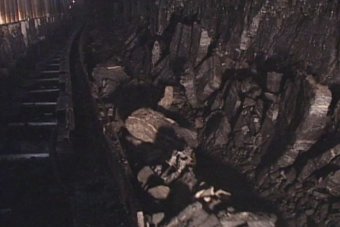
The Thoracic Society of Australia and New Zealand said a national body must be formed to monitor the disease’s spread.
The potentially fatal disease is caused by breathing in excessive levels of coal dust.
But a resurgence of the deadly coal workers’ pneumoconiosis has caught governments and medical authorities by surprise.
It was thought black lung disease had been eradicated from Australian coal fields 60 years ago, but there are now six confirmed cases in Queensland.
Society president Dr Peter Gibson said the news came as a shock to medical professionals.
“Because coal mining is a nationwide activity we feel that we need to know how common this is throughout the whole of Australia and why this is happening,” he said.
“And for that, we think that there needs to be a nationwide response to this issue.
“Black lung is a preventable disease. It’s a disease that’s caused by exposure to coal mine dust and if you can control that exposure and detect people early in the course of the illness then you can prevent a lot of the sickness and disability.
“What we’re worried about is if cases are occurring again in Queensland then what might be happening through the rest of Australia.”
An interim report for the Queensland Government’s independent review of black lung disease will be handed down today.
‘Coal dust monitoring must be reviewed’
Queensland Mines Minister Dr Anthony Lynham commissioned the urgent review by Monash University, to investigate why the department’s health monitoring system failed to check hundreds of thousands of miners’ x-rays.
A Senate inquiry is also investigating the reappearance of the deadly illness.
But Dr Gibson said the response was simply not comprehensive enough, and black lung should be made a notifiable disease.
“We’re talking about standardisation of coal dust exposure limits throughout the country and standardisation of the monitoring protocols the way people are looked at,” he said.
“This is in line with international best practice.
“We’re calling for a comprehensive screening program for workers who might be at risk of exposure, and that this be performed by doctors and x-ray specialists who are not employed by the coal companies and who are specifically trained to look for these illnesses.”
Dr Deborah Yates treated coal-related lung diseases in the UK and is now a respiratory physician at St Vincent’s Hospital in Sydney.
She said Australia’s monitoring limits for coal dust were inconsistent and must be reviewed, as they offer less protection than overseas standards.
“We feel that a national surveillance program is warranted with a unit in every state,” Dr Yates said.
“We feel that a program that has a radiological and also a lung function screening arm is necessary.
“People who are appropriately qualified should actually read all those x-rays.”
Dr Yates said workers should continue having regular screening, even after they had stopped working.
“Australians deserve better. The workers who help us with our economy and who live in very dangerous and rather difficult conditions deserve to be properly monitored and their health deserves to be well cared for.”
Queensland black lung cases ‘the tip of the iceberg’: union
The mining union the CFMEU is in the process of verifying at least two more possible cases of black lung disease.
Queensland mining division president Steve Smyth said the union backed the thoracic society’s calls for a more national approach, to prevent the disease spreading further.
“We’ve put forward a number of recommendations — one is addressing the issues with the failure of the screening and monitoring processes particularly in Queensland,” he said.
“We want independent screening done of workers moving forward. We don’t want what we currently have with the company doctors and radiologists responsible for reviewing these x-rays so overall the medical screening and who does it.
“And secondly we need to fix up what’s happening at the coal face literally with the level of the dust, we need independent monitoring.
And thirdly, we need to get to the bottom of how big and how bad the current issue is with this pneumoconiosis is in Queensland.
“I believe it’s only the tip of the iceberg unfortunately.”
